History of Saratov
Foundation of Saratov
People already lived on the site of today’s Saratov in ancient times. On the territory of the city there is Alekseevskoye settlement - an archaeological monument that has seven identified cultural horizons from the catacomb culture of the Middle Bronze Age (the 20th-19th centuries BC) to the settlements of the Golden Horde time (the 13th-14th centuries AD) with a temporary break in the 5th-13th centuries.
The settlements in this place regularly appeared during periods of relatively stable state structures (Khazar Khaganate, Volga Bulgaria, Golden Horde) and disappeared without a trace during the next wave of nomads. The last such cycle before the founding of Saratov ended in 1395-1396, during the invasion of Tamerlane (Timur), who destroyed the Golden Horde town of Uvek (Ukek) that stood here.
In the next 200 years, the sparse population of this region was represented by Nogai and then Kalmyk nomads, Cossacks and fishing artels of Russian monasteries. After the military campaigns of Russian troops against the Kazan Khanate in 1552 and the Astrakhan Khanate in 1556, the Tsardom of Russia gained control of vast territories of the Volga Region. Under Tsar Fyodor Ivanovich, it was decided to found several new fortified towns on the Volga River.
In the summer of 1586, the Samara fortress was founded, in the summer of 1589 - Tsaritsyn (Volgograd). In the summer of 1590, halfway between Samara and Tsaritsyn, the Saratov fortress was founded. The exact location of the original Saratov is unknown. In the winter of 1613-1614, the fortress burned down. In 1617, it was rebuilt on the left bank of the Volga, at the mouth of the Saratovka River.
In 1674, Saratov was moved to the right bank of the Volga, to the area of the present Muzeynaya Square. Thus, the city of Saratov was founded three times: in 1590, 1617, and 1674, and each time in a new place.
More Historical Facts…
Saratov in the 18th-19th centuries
In 1700, the population of Saratov was about 2,000 people. The sedentary agricultural population for a long time could not populate the territory of the region. Only those who were attracted by the free life of the Cossacks moved here.
The construction of the Tsaritsyn guard line and other measures taken by Peter I to strengthen security created conditions for the settlement of the right bank of the Volga. Its location at the intersection of the shortest land route to Moscow and the water route from the lower Volga and the Caspian made Saratov an important transit point and a major center for trade in fish and salt.
In 1763, foreigners were invited to settle in the Volga Region. In 1766, Saratov became the center of coordination of German colonists. In 1780, the town became the center of the Saratov Vicegerency. In 1796, it was renamed the Saratov Governorate.
In 1811, the population of the town was 26,700 people. The general plan of Saratov, approved in 1812, became the basis for the development of the town for more than a hundred years. The French invasion of Russia (1812) influenced the life of Saratov. In 1813, the French prisoners of war were exiled here and used for public works to level ravines, build dams, plant gardens. Later, a lot of them took Russian citizenship and stayed in Saratov. Some of them were invited as tutors and teachers to Russian families and educational institutions, others opened their workshops.
In 1828, the Saratov Tobacco Factory, one of the first in the Russian Empire, began production. In addition to it, the town had a rope, tannery, bell, brick, and a number of other factories. Cholera epidemics broke out in Saratov in 1830 and 1848. The epidemic of 1830, which lasted more than one month, claimed up to 10,000 people.
The further growth of crafts and trade stimulated the development of river shipping on the Volga, which became the main transport artery of the Russian Empire. In the 19th century, Saratov turned into a major river port. A very strong impetus for the development of the Saratov Governorate was the construction of the Tambov - Saratov railway in 1871. It connected Saratov with the country’s railway network.
In 1876, the first stationary circus in the Russian Empire was built in Saratov. In 1885, a public art museum was opened, which became a major event in the cultural life of the city. In the end of the 19th century, Saratov was one of the largest centers for the grain trade and flour-grinding industry in the country. It became a major intermediary in the trade of oil products, meat, fish, salt, and wool.
Saratov in the 20th century
In 1908, trams began to carry passengers in Saratov - one of the oldest tram systems in Russia. In 1912, the Saratov Conservatory was opened - the third in the country after Moscow and St. Petersburg. In 1914, its population was 235,300 people. Until the end of the 1920s, Saratov remained the largest of the cities of the Volga Region (larger than Kazan, Nizhny Novgorod, Samara, etc.) and was often unofficially called the “capital of the Volga region”. From 1928 to 1932, Saratov was the administrative center of Lower Volga Krai, since 1934 - Saratov Krai, since 1936 - Saratov Oblast.
The rapid development of the city took place during the Second World War, when a number of factories and military schools were evacuated here from the west of the USSR. Saratov was subjected to several German air raids, the main purpose of which was to destroy the bridge over the Volga and the oil refinery.
Before the war, the town of Pokrovsk (Engels) located just across the Volga River was the capital of the German autonomous region with a population of about 800,000 people. A lot of them (about 400,000) were exiled to Siberia and Kazakhstan during the war; some later came back. Since the 1980s, most of them have emigrated to Germany. Until now, the few surviving buildings in the pseudo-Gothic style remind of this page in the history of Saratov.
Yuri Gagarin, the first man in space, studied in Saratov. In 1955, he graduated with honors from the Saratov Industrial College. After his historic flight, Gagarin also landed about 35 km from Saratov - on the left bank of the Volga.
Saratov’s population peaked in 1987 - 918,000 people. Until 1992, Saratov was a closed city (foreigners were not allowed to visit it), since several large enterprises of the Soviet defense industry worked in the city, in particular, the Saratov Aviation Plant, which produced military and civil aircraft. Several industrial enterprises in Saratov also carried out orders for the Soviet space program.
Streets of Saratov
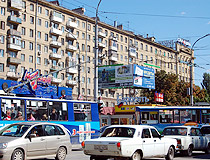
Street traffic in Saratov
Author: Kiyanovsky Dmitry
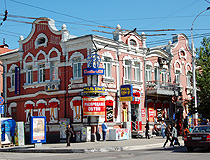
Picturesque old building in Saratov
Author: Kiyanovsky Dmitry
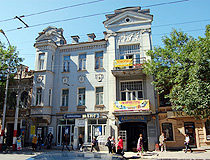
Architectural monument in Saratov
Author: Kiyanovsky Dmitry
Saratov - Features
Saratov stretches for 34 km along the right bank of the Volgograd Reservoir (the Volga River) opposite the mouth of the Saratovka River and the city of Engels, which is located on the opposite bank. The distance from Saratov to Volgograd - 376 km, Samara - 425 km, Moscow - 847 km. The City Day of Saratov is celebrated on the second Sunday in September.
There are several hypotheses about the origin of the name of Saratov. One of the main versions is that Saratov got its name from Sokolovaya Mountain, which was called “sary tau” in Tatar meaning “yellow mountain”. There is an assumption that the name came from the words “sar atav” - “low-lying island” or “saryk atov” - “hawk island”. It is also possible that Saratov got its name from the Scythian-Iranian hydronym “Sarat”.
Three silver fish (sterlet) are depicted on the coat of arms of Saratov symbolizing “the great abundance of such fish in this area”. They form the Greek letter “upsilon” meaning “the choice of a worthy path at the crossroads of life’s roads”.
The climate in Saratov is moderately continental. This city is characterized by long (about four months), moderately cold winters and hot, often dry summers. The average temperature in January is minus 7.5 degrees Celsius, in July - plus 22.6 degrees Celsius. The best time to visit Saratov is from late May to early September.
Saratov is located at the intersection of main railway and highway lines, water routes. The international airport “Gagarin” offers regular flights to Yekaterinburg, Krasnodar, Moscow, Nizhny Novgorod, St. Petersburg, Sochi, Surgut, Ufa.
Trains to Moscow regularly depart from Saratov railway station, as well as passing trains to Adler, Astrakhan, Volgograd, Yekaterinburg, Kislovodsk, Kirov, Krasnoyarsk, Nizhnevartovsk, Nizhny Novgorod, Novokuznetsk, Novorossiysk, Perm, St. Petersburg, Simferopol, Tyumen, Chelyabinsk. The river port of Saratov serves only passengers of intercity cruise ships.
Saratov is a large industrial, cultural and educational center. Machine building, chemical and oil industries are well developed here. There are a lot of various attractions in Saratov: historical, architectural, religious and natural, various museums and beautiful parks. The city has a large number of architectural monuments of the late 19th - early 20th centuries.
Main Attractions of Saratov
Victory Park on Sokolovaya Mountain. This memorial complex was created in Saratov in 1975, when the 30th anniversary of the Victory in World War II was celebrated. This large park covers an area of 80 hectares. Here you can find the Eternal Flame, the Museum of Military and Labor Glory, the 40 meters high monument “Cranes”, and a unique exposition of military and civilian equipment with over 200 exhibits.
In 2003, the National Village of the Peoples of Saratov Oblast was opened in the park with real houses, yurts and other dwellings of the peoples of the region. In this place you can feel the atmosphere of the past not only of Russians, but also of Tatars, Armenians, Bashkirs, Georgians, and other peoples living in the Saratov region. In 2013, the Alley “Days of Russian Military Glory” was solemnly opened, on which monuments to prominent Russian commanders and statesmen were erected.
Victory Park is a favorite place for recreation for locals and visitors of the city. The top of Sokolovaya Mountain is one of the highest points in Saratov (165 meters). The observation deck located here offers a magnificent view of Saratov, the Volga River and its islands, the opposite bank, and the city of Engels (Saratov is connected with it by a bridge). Sokolovaya Street.
Cosmonauts Embankment - a street that stretches for 1.5 km along the Volga to the Saratov Bridge. The embankment received its present name in 1962 - after the first cosmonaut of our planet landed near Saratov. The monument to Yuri Gagarin was erected at the beginning of the embankment more than 30 years later. The embankment descends to the Volga in 4 wide terraces. In summer, there is a rental of bicycles, rollers, and gyro scooters.
In 2017, the floating light and music fountain “Heart of the Volga” was opened here. It is located right on the water, its multicolored jets rise to a height of 40 m. The fountain is open from May to October.
The embankment offers an excellent view of the Saratov Bridge (1965) - a reinforced concrete road bridge across the Volga River connecting Saratov with the city of Engels. The length of the bridge is over 2.8 km. It is one of the symbols of Saratov.
Kirov Avenue - a pedestrian street that stretches for 1 km through the historic center of Saratov. Unofficially, the street is called “Saratov Arbat”. Along the entire length of the street there are mansions and houses built in the late 19th - early 20th centuries. The most interesting ones are the neo-Gothic building of the Saratov Conservatory (1902) and the Volga Hotel (1917) built in the Art Nouveau style. The monument to the Saratov accordion, one of the symbols of Saratov, is installed here.
The walking area starts from Kirov Square, where one of the oldest stationary circuses in Russia is located - the Nikitin Brothers Circus. The fountain near the circus is a traditional meeting place. The building of the Covered Market (1916) located here is also worth mentioning.
Pictures of Saratov
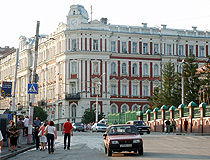
The building of the Volga railway administration in Saratov
Author: Kiyanovsky Dmitry
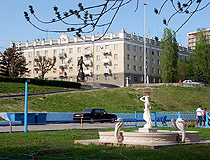
Summer in Saratov
Author: Kiyanovsky Dmitry

Saratov architecture
Author: Kiyanovsky Dmitry
Church of the Icon of the Mother of God (1904-1906) - a very picturesque church, the main feature of which is that its multicolored domes resemble the Cathedral of St. Basil the Blessed standing on Red Square in Moscow. In Soviet times, the building served as a city planetarium. So it has been fairly well preserved. Volzhskaya Street, 36.
Cathedral of the Life-Giving Trinity (1689-1695) - the main Orthodox church in Saratov, a unique architectural monument for the Saratov region built in the Moscow baroque style. Moskovskaya Street, 6.
Saratov Regional Museum of Local Lore - the largest museum organization in Saratov Oblast. In total, the museum has about 400 thousand exhibits: archaeological, ethnographic, paleontological, entomological collections, examples of manuscript and early printed books, objects of religious worship, poster graphics, numismatics, materials on the history of the political, economic, and cultural life of Saratov.
Among the numerous exhibits on display in 30 spacious halls, it is worth highlighting the complete skeleton of an ichthyosaur, utensils belonging to the 4th century BC, a rare saber granted by Empress Elizabeth to the clerk Panteley Selivanov. In addition to the permanent exhibition, the museum organizes thematic exhibitions. Lermontova Street, 34.
The Radishchev Art Museum. Created in 1885, it became one of the first publicly accessible art museums in the Russian Empire. The ground floor displays medieval icons and a collection of Western European art, which is considered the third largest in Russia. These are canvases by Dutch, German, French, and Italian artists, furniture and porcelain, bronze and glass products.
On the second floor, you can see the works of Russian painters. Musical concerts and literary and art meetings are held in the Great Hall of this art museum. The library of the museum has a rich collection of manuscripts, old books. Radishchev Street, 39.
Museum of Samovars. This private museum, opened in 2015, houses the largest collection of samovars in Russia - over 700 pieces. Today, in a small room on the ground floor of a residential building, you can see samovars from all over the world and trace their evolution over several centuries. Over time, these ordinary kitchen utensils have turned into works of art and have become one of the symbols of Russia. Kutyakova Street, 34/36.
Gagarin’s Field (Gagarin’s Landing Site). This attraction of Saratov is located outside the city. On April 12, 1961, the landing vehicle of the Vostok-1 spacecraft with Yuri Gagarin on board landed near the village of Smelovka in Saratov Oblast, several kilometers south of Saratov.
According to the pre-flight plan, the landing was to take place in the steppes of Kazakhstan, but due to a failure in the braking system, Vostok-1 landed on the field of the collective farm “Lenin’s Path”. Yuri Gagarin himself considered his landing near Saratov to be symbolic. In this city the first cosmonaut of the planet attended an industrial technical school.
Today, a memorial complex has been created on this field with a 27-meter obelisk in the form of a rocket taking off. It is a smaller copy of the Monument to the Conquerors of Space located near the Museum of Cosmonautics in Moscow. Near the obelisk, there is a monument to Yury Gagarin, a descent vehicle, and 12 steles with images of the first cosmonauts, Konstantin Tsiolkovsky, and Sergei Korolev. There is a small park around the complex.


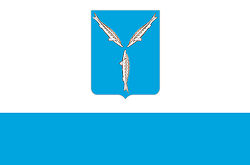
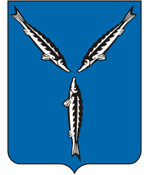
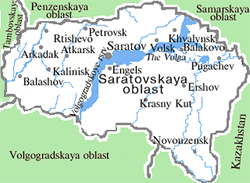






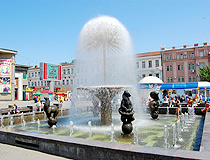
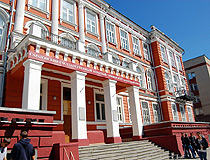

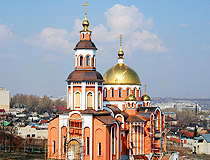
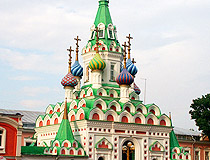
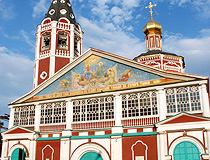
The comments of our visitors